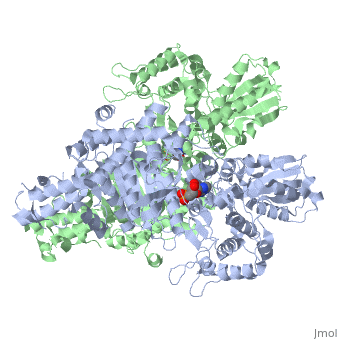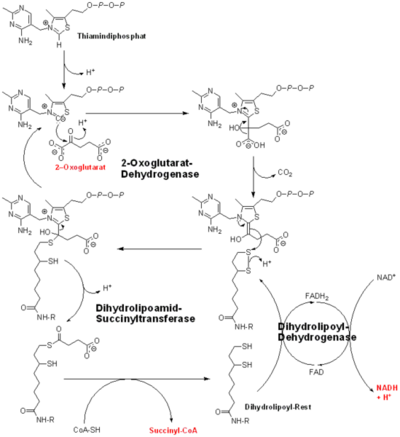2-Oxoglutarate Dehydrogenase
From Proteopedia
(Difference between revisions)
| Line 4: | Line 4: | ||
__TOC__ | __TOC__ | ||
==Catalysis== | ==Catalysis== | ||
| - | [[Image:oxoglutarate dehydrogenase.png|thumb|left| | + | [[Image:oxoglutarate dehydrogenase.png|thumb|left|400px|The complete reaction of the Oxoglutarate Dehydrogenase Multi-Enzyme Complex]] |
{{Clear}} | {{Clear}} | ||
E1o catalyzes the oxidative decarboxylation of alpha-ketoglutarate to Succinyl-CoA at its <scene name='Lucas_Evans_Sandbox/Active_site/1'>active site</scene> in the fourth step of the metabolic citric acid cycle by acting as a base to facilitate the decarboxylation <ref name="one" />. The main residues responsible for the catalysis are thought to be His 260, Phe 227, Gln685, His 729, Ser302, and His 298 <ref name="one" />. E1o is also thought to have a single active site. E1o also requrires two cofactors in order for it to function properly, Thiamine diphosphate and divalent magnesium ion if either are not present then the enzyme has nearly no activity<ref name="two">PMID:192200 </ref>. The specific mexhanism of the E1o subunit are currently unknown; however, There are several theories as to how it functions, among them is the Hexa Uni Ping Pong theory<ref name="two" />. Even though the mechanism isn't fully know the kinetic data have be calculated and are as follows: | E1o catalyzes the oxidative decarboxylation of alpha-ketoglutarate to Succinyl-CoA at its <scene name='Lucas_Evans_Sandbox/Active_site/1'>active site</scene> in the fourth step of the metabolic citric acid cycle by acting as a base to facilitate the decarboxylation <ref name="one" />. The main residues responsible for the catalysis are thought to be His 260, Phe 227, Gln685, His 729, Ser302, and His 298 <ref name="one" />. E1o is also thought to have a single active site. E1o also requrires two cofactors in order for it to function properly, Thiamine diphosphate and divalent magnesium ion if either are not present then the enzyme has nearly no activity<ref name="two">PMID:192200 </ref>. The specific mexhanism of the E1o subunit are currently unknown; however, There are several theories as to how it functions, among them is the Hexa Uni Ping Pong theory<ref name="two" />. Even though the mechanism isn't fully know the kinetic data have be calculated and are as follows: | ||
Revision as of 15:40, 13 May 2015
| |||||||||||
3D structures of 2-Oxoglutarate dehydrogenase
Updated on 13-May-2015
References
- ↑ 1.0 1.1 1.2 1.3 Frank RA, Price AJ, Northrop FD, Perham RN, Luisi BF. Crystal structure of the E1 component of the Escherichia coli 2-oxoglutarate dehydrogenase multienzyme complex. J Mol Biol. 2007 May 4;368(3):639-51. Epub 2007 Feb 7. PMID:17367808 doi:10.1016/j.jmb.2007.01.080
- ↑ 2.0 2.1 McMinn CL, Ottaway JH. Studies on the mechanism and kinetics of the 2-oxoglutarate dehydrogenase system from pig heart. Biochem J. 1977 Mar 1;161(3):569-81. PMID:192200
- ↑ Leung PS, Rossaro L, Davis PA, Park O, Tanaka A, Kikuchi K, Miyakawa H, Norman GL, Lee W, Gershwin ME. Antimitochondrial antibodies in acute liver failure: implications for primary biliary cirrhosis. Hepatology. 2007 Nov;46(5):1436-42. PMID:17657817 doi:10.1002/hep.21828
- ↑ Voet, Donald, Judith G. Voet, and Charlotte W. Pratt. Fundamentals of Biochemistry: Life at the Molecular Level. Hoboken, NJ: Wiley, 2008. p.580
Proteopedia Page Contributors and Editors (what is this?)
Michal Harel, David Canner, Lucas Evans, Alexander Berchansky, Joel L. Sussman


